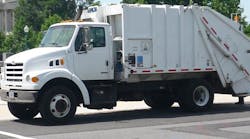Two years after testing on three trucks began in southern Florida, Parker Hannifin Corp. announced today that Miami-Dade County in south Florida has placed an order for 29 Autocar E3 refuse trucks featuring Parker’s fuel-saving RunWise technology. These vehicles are being used in municipalities across the country yielding significant reliability and performance measures.
“We have invested significantly in the development of this technology and to see its benefits be proven out in the marketplace is very rewarding,” said Jeff Cullman, President – Hydraulics Group. “Miami-Dade has seen some tremendous results with their test fleet and we are pleased they have made such a strong commitment to the technology with this large order. While they were able to secure federal EPA funding for half of this order, investing their own money demonstrates the positive economics and payback on the technology as a stand-alone purchase.”
Miami-Dade used funding from the United States Environmental Protection Agency to purchase 15 of the vehicles as part of the National Clean Diesel Campaign’s Emerging Technologies List. RunWise is the only drivetrain technology on the list.
Application update
As we reported in the past, the hybrid system features a hydrostatic drive, which efficiently handles highway speeds and brake energy recovery technology. Power comes from an engine's input shaft into Parker's Power Drive Unit assembly (PDU), which generates hyraulic power to drive two hydrostatic motors, or charge accumulators. The hydrostatic motors drive the output shaft through a simple two-speed (low or high) gear reduction. The vehicle always starts in low and shifts to high at a predetermined speed. Upon reaching highway speed, the PDU shifts from high hydrostatic to direct drive.
“We’ve been very pleased with the overall performance of the vehicles with RunWise technology, said Danny Diaz, Director of Fleet Management for Miami Dade County. “The savings we are seeing is significant when you look at the long-term with these hybrid trucks.”
Beyond brake energy recovery capabilities and reduced noise levels, the Autocar refuse trucks equipped with RunWise technology commonly demonstrate annual fuel savings in the range of 35 to 50% with the hybrid drive system for the automatic side loader, reusing as much as 71% of the vehicle’s braking energy. Additional benefits include reduced maintenance costs, less engine wear and tear as well as extended brake life.
The RunWise version of the Autocar trucks is currently in operation in Miami-Dade County and other cities around the country including in Hialeah, Fla.; Miami; Seymour, Ind.; and Austin, Texas.
Vist parkerhybrid.parker.com for more details.

